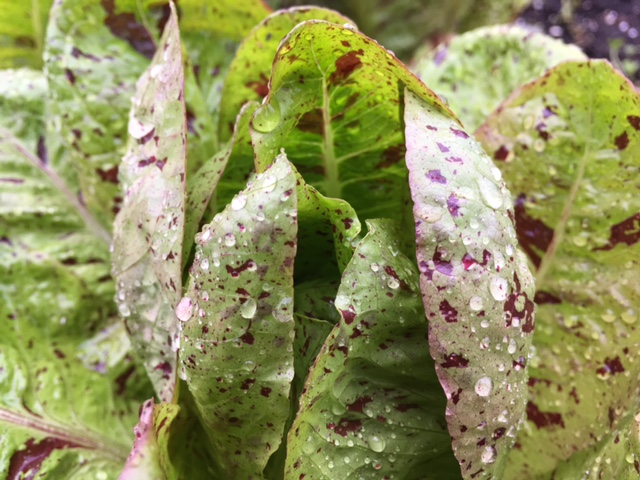The maroon van with yellow lettering displaying Wrangell Institute for Science and Environment (WISE) bounced down the McCarthy road on a beautiful day in July. A grey Bureau of Land Management (BLM) truck followed carrying additional gear and partner instructors. At the end of the road gear was checked, divided, and backpacks donned for the first mile trek across the bridge to Wrangell Mountains Center (WMC). We were greeted by friendly staff, McCarthy youth and adult participants, and a wonderful dinner of fresh garden salad, vegetable chili, rice, fruit, and brownies. The famous Kenny Lake Jan Carlson thank you song was taught and sung to the chefs and other instructors throughout the program.
Twenty excited participants in the first Geology Backpacking partnership program (WISE, WMC, BLM, and National Park Service) got to know each other through questions, stories, jokes and metaphors. Evening lessons brought us the short distance to the shores of McCarthy Creek where we got a lesson on rocks from Barry Hecht and Mary Gianotti. We were split into pairs, instructed to each pick up two rocks that piqued our curiosity and share with our partner: something we noticed about it, what it reminded us of, and what it made us wonder about it. After sharing these thoughts we learned about the different kinds of rock – sedimentary, igneous, and metamorphic – how they were formed, and identified those we wondered about.
The next morning gave promise to a beautiful day to back pack and commune with the glacial landscape and its icy core. After a hearty WMC breakfast of oatmeal, homemade granola, fruit, and coffee cakes we piled in the shuttle van to Kennecott. As we stood between towering red historic mining buildings above National Creek, we turned our bodies into glaciers carving miniature glacial landscapes in the gravel, labeling formations that added new words to our vocabulary: arête, erratic, cirque, headwall, esker, lateral and terminal moraines. After the lesson, scattering our miniature glacial landscapes, and having a picnic lunch we lifted our packs to our backs and headed for the Root Glacier.
The trail was fairly flat traversing above the lateral moraine, skirting through spruce, small balsam poplar, willow and soapberry bushes. Spruce trees created window frame views of illusive ice covered in a river of grey gravel peaks flowing like rapids from the glacier tongue. After more than a mile of trekking, the trail began a steep decent to the camping spot above the glacier. After setting up camp, Park Service geologist, Mike Loso and WMC Board member and owner of Kennicott Wilderness Guides, Jared Steyaert joined us to be our guides and instructors for the glacier trek. We transformed our backpacks into day packs, stuffing them with extra warm coats, snacks, and crampons. A line of 22 of us snaked our way down the lateral moraine to the base of white glacier ice. There we paused and Jared gave instructions on strapping on crampons, demonstrated walking bull legged uphill and digging in straight downhill – all in slow stomping baby steps. Our expert guides gave us safety rules and then led us on an ice enchanted adventure. Melting ice carved waterfalls, creeks and rivers, cutting and gathering the ice into more water droplets. Day by day, swirling, dancing around and around, the artist sculpture carving deep blue holes called moulins into the bowels of the glacier. Drop after drop meeting to make a hidden massive under glacier water slide in perpetual motion.
We filled our water bottles and drank this ancient pure water offered to us in deep blue moving pools and narrow channels. The massive headwall of the glacier rose like a kingdom as we walked in its outstretched hand. Bare mountain peaks stood amidst this icy kingdom. The adventure enveloped us with lessons, respect, silence, movement, peace, excitement, invigoration, and pause to contemplate and wonder. The glaciers demands put a strain on the legs and body, one that gave appreciation and respect for dynamic forces controlled by water.
The next morning our new vocabulary and analogies were put to the test in a variation of charades. Three teams dubbed metamorphic, igneous, and sedimentary raced to get their team to guess the most terms, words, and metaphors. The active and fun lessons became cemented in our brains like metamorphic rock.
The end of the journey took us back to Wrangell Mountains Center in McCarthy where we shared a last delicious meal, our thoughts of the experience, and how it might affect our future lives. WMC instructors and McCarthy participants graciously helped carry some of our gear the mile to the vehicles. In a new light the terminal moraine cast its forces upon us as we said our goodbyes to new friends and reflected on the camaraderie of shared exciting moments, solid as the rocks that formed over time.














![Peregrine FalconBy Stefan Berndtsson (Pilgrimsfalk / Peregrine Falcon) [CC BY 2.0 (http://creativecommons.org/licenses/by/2.0)], via Wikimedia Commons](https://images.squarespace-cdn.com/content/v1/51ddb936e4b0bf85e2f4d9eb/1474323222737-GE8U5H61DPOEANHQ5KTN/image-asset.jpeg)
![American KestrelBy Tony Hisgett (originally posted to Flickr as American Kestrel 3) [CC BY 2.0 (http://creativecommons.org/licenses/by/2.0)], via Wikimedia Commons](https://images.squarespace-cdn.com/content/v1/51ddb936e4b0bf85e2f4d9eb/1474324567658-ERZ0OQ4EHVIZBQC4QOMJ/image-asset.jpeg)
![Falconry IllustrationBy unknown artist [Public domain], via Wikimedia Commons](https://images.squarespace-cdn.com/content/v1/51ddb936e4b0bf85e2f4d9eb/1474323349211-PNTH0DQKQRUB67WURF9X/image-asset.jpeg)














